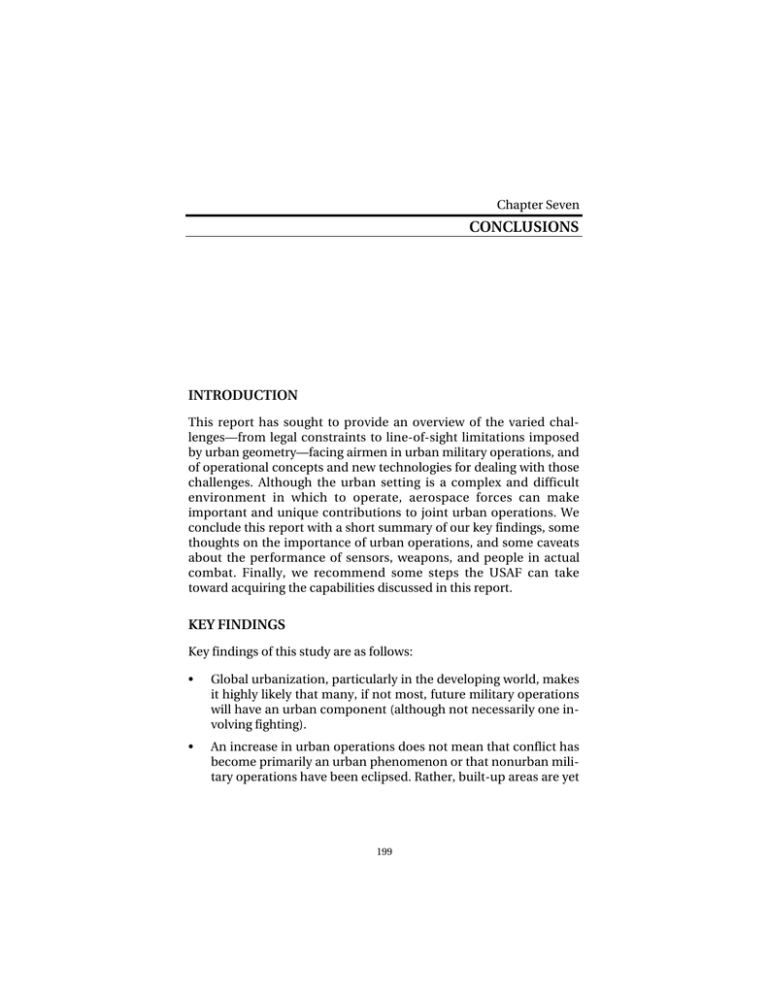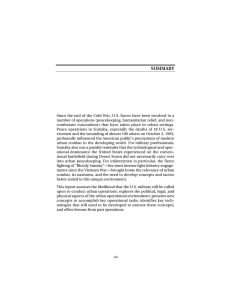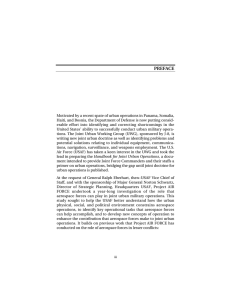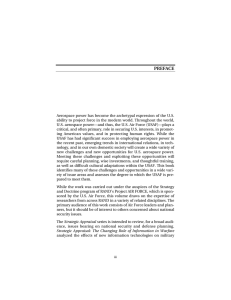CONCLUSIONS INTRODUCTION
advertisement

Chapter Seven CONCLUSIONS INTRODUCTION This report has sought to provide an overview of the varied challenges—from legal constraints to line-of-sight limitations imposed by urban geometry—facing airmen in urban military operations, and of operational concepts and new technologies for dealing with those challenges. Although the urban setting is a complex and difficult environment in which to operate, aerospace forces can make important and unique contributions to joint urban operations. We conclude this report with a short summary of our key findings, some thoughts on the importance of urban operations, and some caveats about the performance of sensors, weapons, and people in actual combat. Finally, we recommend some steps the USAF can take toward acquiring the capabilities discussed in this report. KEY FINDINGS Key findings of this study are as follows: • Global urbanization, particularly in the developing world, makes it highly likely that many, if not most, future military operations will have an urban component (although not necessarily one involving fighting). • An increase in urban operations does not mean that conflict has become primarily an urban phenomenon or that nonurban military operations have been eclipsed. Rather, built-up areas are yet 199 200 Aerospace Operations in Urban Environments another environment in which military forces must be prepared to operate. • The physical and social complexity of urban areas makes them extremely difficult to operate in. Where possible, U.S. forces should avoid them. Aerospace forces can help preclude some urban military operations through deterrence, early warning, and rapid humanitarian or military intervention. Along with ground-based long-range fires, they can interdict adversary forces, potentially preventing them from reaching urban areas. • Where urban operations cannot be avoided, aerospace forces can make important contributions to the joint team, detecting adversary forces in the open; attacking those forces in a variety of settings; and providing close support, navigation and communications infrastructure, and resupply for friendly ground forces. • Offboard sensors for manned aircraft, three-dimensional urban mapping, GPS relays on UAVs, and limited-effects munitions have the potential to enhance the ability of aerospace forces to detect and attack adversary forces where rules of engagement are highly restrictive, such as in peace operations, noncombatant evacuations, and humanitarian assistance. Their development should be encouraged. • Three-dimensional mapping and GPS relays also have the potential to substantially improve the situational awareness of friendly ground forces, allowing the smallest units, as well as their commanders, to know their own location (both GPS coordinates and position in buildings). Coupling these technologies with laser rangefinders should allow friendly forces to quickly map the location of engaged adversary forces. • Automated integration and pattern analysis of inputs from large, multiphenomenology sensor networks will be necessary to make sense of the massive volume of activity found in most urban areas. • But, in the type of limited operations this report emphasizes, it is unlikely that automated classification of weapons, adversary personnel, or vehicles will be sufficiently reliable to permit lethal fires to be put automatically on targets. Rather, we expect that Conclusions 201 practical limitations of automated fusion, coupled with political concerns about collateral damage and civilian casualties, will dictate that at least one human decisionmaker remain in the loop between sensor and shooter. • As long as human decisionmakers remain in the loop between sensor and shooter, human-machine interfaces will be a critical information-architecture issue. A major challenge will be developing the organizational processes that make quick decisions possible in light of the likely uncertainty and ambiguity associated with real combat. Without a responsive and agile command and control system, an elusive and adaptable adversary is likely to be there and gone before weapons can be brought to bear. THE NEED FOR IMPROVED URBAN OPERATIONAL CAPABILITIES Are urban-centered conflicts becoming more common? Are they a new form of warfare that will supplant traditional maneuver warfare in the open? These are intriguing questions that deserve serious and careful consideration by defense planners and researchers alike. At this point, there is insufficient evidence or analysis to answer them. In finding answers, defense planners must walk a narrow path between apocalyptic and complacent visions of the future security environment. They should focus, at least for now, on ensuring that the U.S. military can meet a broad range of urban-military-operation challenges, whether in major wars or small-scale operations. The best argument for improved urban-military capabilities is that, despite its best efforts to avoid them, the U.S. military has had to fight in cities in a multitude of circumstances. And, in an increasingly urbanized world, noncombatant evacuations, humanitarian relief, and other “noncombat” operations are likely to take place in urban settings. The possibility of armed interference in many of these operations means that the military is tasked. Although U.S. forces have usually been able to avoid combat during these operations, they must be prepared to conduct urban evacuations and humanitarian relief in the face of armed opposition. In short, whether in conventional conflicts or in smaller-scale contingencies, there is a good chance that U.S. forces will be called upon to operate in urban set- 202 Aerospace Operations in Urban Environments tings. Prudent defense planning requires that we develop the doctrine, training, organizations, equipment, and concepts of operations to be effective in this unique and difficult environment. Planners also need to distinguish clearly between the problem of conducting military operations in the midst of a civilian population and that of fighting in the rubble of a largely abandoned city. The former, more-complex problem deserves analytic attention. As DoD places more emphasis on stability, relief, counterterrorism, and other operations at the lower end of the conflict spectrum, planners, operators, and analysts need to gain a deeper understanding of the human and physical intricacies of the urban environment. TECHNOLOGICAL PROMISES AND THE REALITY OF WAR The concepts presented in this report have great promise, but we do not want to imply that the concepts or enabling technologies are a panacea that will make urban operations easy or guarantee U.S. dominance of the urban environment. The urban environment is too complex to lend itself to a simple technological solution. Even with an extensive aerospace-ground sensor network, much adversary activity is likely to go undetected. Smoke (from fires and adversary smoke-generating machines), dust, inclement weather, night, electronic interference, building materials, and human activities will hinder intelligence collection at one time or another. An adversary force’s efforts at deception will, at times, confuse and confound U.S. attempts to detect and attack them. Adversary forces that are detected by ground-sensor fields may move out of sensor range or line of sight before they can be positively identified or attacked. Airborne surveillance platforms at times may be too far off to assist or may lose line of sight at critical moments. Around-theclock airborne fire support, which is feasible but demanding for platforms and crews, does not ensure that a weapon can be delivered anywhere in the city at a moment’s notice. In many cases, adversary forces are likely to escape before the sensor-controller-shooter loop can be completed. A highly active adversary might swamp controllers with alerts, hampering the time-consuming task of visually identifying the targets. Or it might not be possible to identify the targets as hostile because the targets are intermingled with noncombatants. Conclusions 203 There also will be occasions when weapons will be released but will miss the intended target because of these factors or adversary countermeasures. At least some of the time, both lethal and nonlethal weapons will injure and kill noncombatants and friendly forces. Limited-effects munitions are also likely to be insufficiently lethal in some situations, allowing adversary forces to escape unscathed or with lesser injuries than they would have received from traditional weapons. Thus, although the weapons proposed here can substantially lessen unintended damage, they will at times fail to achieve the desired effect. Finally, it must be recognized that the adversary is a thinking, adapting, often highly motivated independent actor who will do creative and surprising things to counter U.S. sensors, weapons, and concepts of operation. Concepts of operation will have to be flexible and evolve to stay one step ahead of such a thinking adversary. The greatest advantage U.S. forces have over potential adversaries is their ability to integrate air, land, sea, and space forces. In the urban setting, highly integrated operations could allow a ground patrol to send GPS coordinates and/or an image of an adversary’s position to a combat aircraft overhead. Alternatively, a UAV, manned aircraft, or satellite might send GPS coordinates, an image, or other data about a target that was around the corner or otherwise beyond line of sight to a ground unit. Mutual sharing of information and images could dramatically increase the effectiveness of both aerospace and ground forces as they gained a perspective on a developing situation impossible to achieve from either the ground, air, or space alone. Integrating inputs from ground, air, and space sensors, along with human observations from patrols or forward observers, could also give commanders a rich, multidimensional view of the battlespace, improving the quality and speed of force allocation and other critical command decisions. Fully integrated air-ground operations that capitalize on the unique strengths of ground and air forces should minimize U.S. susceptibility to an adversary’s deception efforts and risks to U.S. personnel while maximizing the effectiveness of U.S. forces in detecting, identifying, and neutralizing adversary forces. 204 Aerospace Operations in Urban Environments NEXT STEPS The caveats discussed above notwithstanding, the general approach presented here is sound and, if pursued, will yield a significant improvement in USAF and joint capabilities for urban operations. In particular, the integration of ground-sensor networks, low-flying airlaunched UAVs, and more-traditional surveillance platforms with platforms carrying limited-effects munitions will make it possible for aerospace forces to greatly increase the contribution they make to joint urban operations. Developing the ability to detect, identify, and neutralize room-sized targets without collateral damage is a logical step in the evolution of aerospace power, simply continuing current trends in C3ISR, battle management, and precision strike. For these capabilities to be realized, several areas will require morefocused attention: • Air-launched offboard sensors • Limited-effects munitions and associated platforms • Non-imaging sensors for ground networks (particularly weapondetection and explosives-detection technologies) • Three-dimensional mapping and databases • Sensor fusion • Joint command and control of aerospace and ground forces. In view of budgetary realities and current modernization priorities, we recognize that funds available for enhancing USAF urban capabilities are limited. USAF R&D is already directed at certain capabilities that would be useful in urban settings, such as loitering sensors/platforms and directed-energy weapons. However, programs would have to be initiated or redirected to develop other key urban capabilities. For that reason, we recommend that the USAF continue modest research to identify the most-promising and versatile technologies for urban settings. Additional research and testing will have to be done before there is sufficient data on performance and cost for the USAF leadership to make informed decisions on whether to field systems such as those discussed in this report. Conclusions 205 For the near term, we recommend that one of the USAF major commands or a battle laboratory be given responsibility for conducting additional research and development of these systems. To make the most of limited R&D funds, USAF laboratories should seek to partner with the Defense Advanced Research Projects Agency (DARPA) and other interested parties—perhaps under the auspices of an Advanced Concept Technology Demonstration (ACTD) program—to build and test prototypes of the more promising systems. U.S. allies are likely to be important players as well, having developed a variety of nonlethal, countersniper, and other systems that can be applied in urban operations. Ultimately, urban operations are a joint problem. Theater commanders, the joint staff, and DoD will have to determine which mix of capabilities offers the most robust force for urban operations. Specific sensor and weapon choices will have to be made on the basis of some combination of coverage rate, resolution, versatility, responsiveness, cost, proportional/adjustable effects, and ease of delivery. Urban-specific MOEs may be needed to evaluate options for accomplishing the various tasks. As promising technologies are identified, realistic field testing, simulation, modeling and redteaming will be necessary to determine which, if any, of these are sufficiently robust under actual operational conditions to justify fielding. Likewise, certain capabilities discussed in this report, such as urban pattern analysis and the fusion of aerospace-ground sensor inputs, should be developed under the auspices of joint initiatives. These capabilities belong in a joint fusion or command center. Indeed, some of the most difficult issues are related to joint command and control of urban operations. For example, coordinating joint fires to prevent friendly forces from firing on one another will become a bigger problem if the number of standoff weapons used in urban operations is increased. If significant numbers of friendly forces are on the ground, will all urban air strikes be considered CAS? Or will aerospace forces operate more autonomously in some parts of the city? These are just a few of the many issues that need to be resolved before highly integrated urban aerospace-ground operations become feasible. 206 Aerospace Operations in Urban Environments We also recognize that other potential aerospace applications may prove to be too expensive or too far removed from the core responsibilities of the USAF to justify the diversion of resources. However, it would be unfortunate if excessive concern about budgetary constraints, combined with somewhat outdated views of the limitations of aerospace power, prevented promising new capabilities from being fielded. Ironically, airmen are often as likely as infantrymen to narrowly define the settings in which aerospace forces can contribute. A more expansive vision of aerospace power would see the urban canyons of the world as part of the continuum of the third dimension that runs from the ground to orbital altitudes. It would embrace nontraditional systems—such as air-dropped UAVs—as simply another tool in the airman’s kit bag. The USAF excelled during the twentieth century at going higher, faster, farther. To meet the challenges of the early twenty-first century, the USAF may also need to exploit unmanned and robotic systems so that it can go lower, slower, and closer against unconventional threats to U.S. interests.






